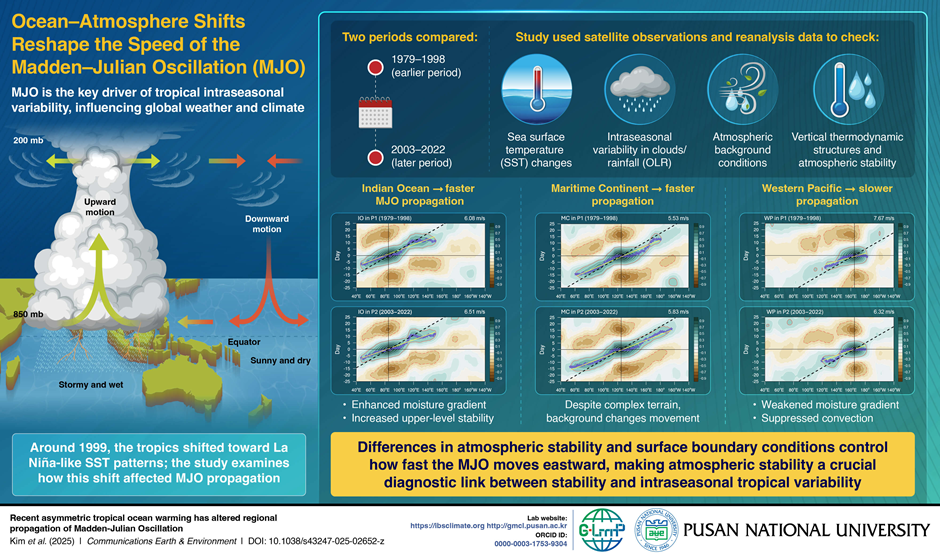
How Uneven Ocean Warming is Altering Propagation of the Madden-Julian Oscillation
Uneven ocean warming reshapes the Madden–Julian Oscillation, altering rainfall patterns and challenging climate prediction
Asymmetric tropical ocean warming since 1999 has reshaped the Madden–Julian Oscillation (MJO), a key climate rhythm driving rainfall, monsoons, and storms worldwide. Researchers using satellite and reanalysis data found the MJO now moves faster over the Indian Ocean and Maritime Continent but slows over the western Pacific. These shifts show how uneven ocean warming reorganizes tropical convection, with vital implications for improving climate models, forecasts, and resilience to extremes.

Image title: Shifting Ocean Patterns Reshape the Madden–Julian Oscillation
Image caption: Uneven Ocean warming shifts the pace of the Madden–Julian Oscillation, reshaping global weather
Image credit: The authors
License type: Original Content
Usage restrictions: Cannot be reused without permission
The Earth’s tropical regions drive some of the most powerful weather and climate variability globally. Among these, the Madden–Julian Oscillation (MJO) is a dominant intraseasonal climate signal, characterized by large clusters of clouds and rainfall that slowly move eastward across the warm tropical oceans. In doing so, the MJO shapes rainfall patterns, influences tropical cyclones, modulates monsoons, and even impacts weather far beyond the tropics. Understanding the factors that govern its speed and intensity is therefore essential for improving sub seasonal to seasonal climate forecasts.
In recent decades, ocean surface warming has been uneven. While most tropical oceans have warmed significantly, the central and eastern Pacific has remained relatively cooler, creating a La Niña–like background state. Around 1999, this asymmetry became more pronounced, raising the question: How have these changing ocean–atmosphere conditions affected MJO propagation?
To investigate this, researchers from Pusan National University examined MJO behavior across two periods: 1979–1998 (pre-1999 conditions) and 2003–2022 (La Niña–like state). The lead researcher, Professor Kyung-Ja Ha explained, “The recent asymmetric tropical ocean warming has driven contrasting changes in the regional propagation of the Madden–Julian Oscillation, with faster propagation over the Indian Ocean and Maritime Continent, but slower propagation over the western Pacific.” The study, published in Communications Earth & Environment on August 14, 2025, highlights how uneven ocean warming can reorganize tropical convection and has critical implications for advancing climate models and improving sub-seasonal prediction.
The study relied on a combination of satellite observations and atmospheric reanalysis datasets. These tools allowed scientists to track intraseasonal variations in convection (via outgoing longwave radiation, OLR), assess sea surface temperature (SST) changes, examine large-scale atmospheric circulation, and evaluate the vertical thermodynamic structure, particularly the role of atmospheric stability and moist processes.
The results revealed stark regional contrasts. Over the Indian Ocean, the MJO propagated eastward more rapidly during the later period, aided by stronger horizontal moisture gradients, enhanced pre-moistening ahead of the convection center, and increased upper-tropospheric stability. Over the Maritime Continent, despite its complex land–sea geography, eastward propagation also accelerated, though less markedly. In contrast, the western Pacific experienced a slowdown, driven by weakened moisture gradients, reduced vertical motion, and lower atmospheric stability, which hindered MJO advancement.
A key insight is the role of atmospheric stability, represented by atmospheric stability, in shaping MJO evolution. By linking stability to intraseasonal variability, atmospheric stability serves as a crucial diagnostic for understanding and predicting MJO dynamics.
These findings have direct implications for weather and climate applications. Prof. Ha shares, “By improving how climate models capture the influence of ocean warming on MJO behavior, seasonal-to-decadal forecasts of rainfall and drought risks can become more accurate. This, in turn, enables governments and local communities to plan more resilient infrastructure, agricultural strategies, and water management systems in the face of climate extremes.” By clarifying shifting tropical climate patterns, the findings help policymakers prioritize adaptation in vulnerable regions.
In conclusion, uneven ocean warming is altering climate states and the MJO’s rhythm. Since the MJO shapes rainfall, cyclones, and stratospheric processes, accurately capturing its dynamics is vital for better global forecasts in a warming world.
This study was supported by the PNU Global—Learning & Academic research institution for Master’s, PhD students, and Postdocs (G-LAMP) Program.
Reference
|
Title of original paper: |
Recent asymmetric tropical ocean warming has altered regional propagation of Madden-Julian Oscillation |
|
Journal: |
Communications Earth & Environment |
|
DOI: |
About the author
Professor Kyung-Ja Ha is a climate physicist at the IBS Center for Climate Physics and Pusan National University, where she leads the Global Monsoon Climate Lab. She has served as president of the Korea Meteorological Society and as a member of the Presidential Science and Technology Advisory Committee. With more than 300 publications and 7,000 citations, her research focuses on monsoon dynamics, hydroclimate, and tropical–extratropical interactions. This study was supported by the Global–Learning & Academic Research Institution for Master’s, PhD students, and Postdocs (G-LAMP) Program of the NRF, funded by the Ministry of Education (No. RS-2023-00301938).
 PURCS_172_Infographics_final.jpg
(922KB)
PURCS_172_Infographics_final.jpg
(922KB)